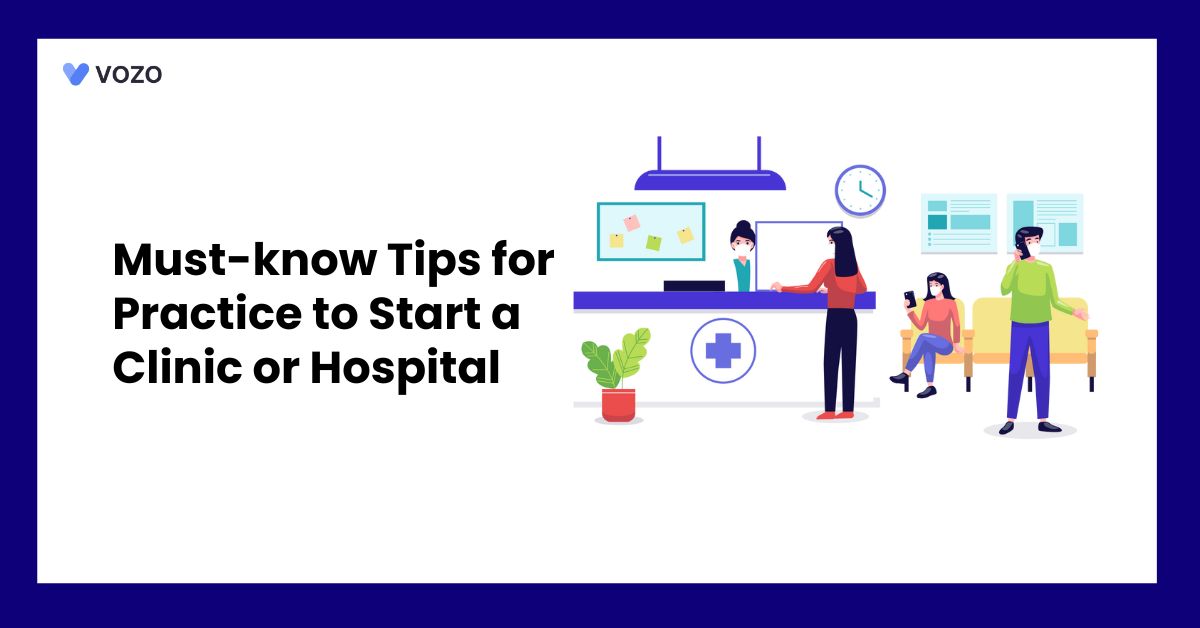Must-know Tips for Practice to Start a Clinic or Hospital
In the United States, there is a significant shift in medical practice ownership, with fewer physicians in private practices and more in bigger, hospital-owned or health system-owned offices.
Starting a private medical practice is a major effort, with a large investment and continuing expenditures. The average expense for launching a medical practice can vary between $70,000 and $100,000, while monthly operating costs may be around $6,000.
This blog will provide you with the must-know tips for starting a clinic or hospital and the steps that need to be taken.
How to Start a Clinic or Hospital?
A clinic or Hospital startup requires extensive research and a huge investment. This involves several steps, which include a business plan, funding, necessary licenses, and more.
3 Main Challenges to Overcome:
- Key Decisions made without involving expert professionals or relevant stakeholders will lead to mistakes in clinical operations and services.
- Low clinic utilization will affect healthcare and will result in financial loss and reduce the quality of care.
- Poor data management, medical records will increase compliance issues and can disrupt care continuity.
Related: Top 5 Benefits of Practice Management Software in 2025
10 Steps to Start a Clinic or Hospital
1. Initial Planning
Strategic planning is the most vital step in starting a clinic, and it includes identifying practice goals, objectives, and a clear roadmap from beginning to end. This allows you to identify your target audience, configure your services, and then allocate resources accordingly.
2. Create a Business Plan
Develop a plan that includes all your practice’s needs, such as financial costs, marketing strategies, equipment, technology, staffing, and challenges. Research and prepare a SWOT analysis based on market trends. Estimate the income and expenses for 3-5 years.
Most importantly, a thorough risk assessment related to patient safety, regulatory compliance, and operational vulnerabilities is required.
3. Secure Funding
Explore options for financial costs such as loans, grants, and investment partnerships. Prepare a strong financial plan and presentations to attract investors that cover salaries, startup costs, and equipment. Consult with an accountant who is an expert in healthcare management.
4. Select Your Practice Location
When choosing a location, consider factors such as accessibility, demographics, competition, and visibility. Make sure your location aligns with your target patient population.
Verify medical zoning and get conditional-use permits; engage local planning departments early to prevent delays. Collaborate with professional healthcare architects to enhance clinical flow, infection control, and patient privacy.
5. Obtain Licenses and Credentials
Obtain necessary medical, drug, and establishment licenses from the concern departments. You’ll need a medical license, NPI, DEA registration, CLIA certification, and comply with federal and state regulations. Make sure all healthcare providers, nurses, and paramedics are licensed and certified.
Related: How to Implement Practice Management Software to Streamline Dental Clinic
6. Set up your Medical Practice
Implement an EHR system and practice management software in your medical practice to enhance productivity and for seamless flow. Consider factors like appointment scheduling, patient portal, record management, medical billing and coding, and communication channels.
Invest in a robust information technology that includes EHR, which is suitable for your practice that has secure storage, network security, and hardware. Join HIE for seamless data exchange. Comply with patient privacy and establish protocols for data backup and cybersecurity to prevent cyberthreats.
7. Human Resources
Hire board-certified physicians, licensed nurses, and allied health professionals; create privileging and credentialing systems that are consistent with CoPs. Onboard practice managers, billing/coding experts, and front-desk staff; teach them on EHR workflows and patient experience protocols. Establish ongoing education for clinical quality improvement, compliance updates, and new technology adoption.
8. Marketing Strategy
Build an SEO-friendly website and claim local listings on Google Business Profile, Healthgrades to dominate “near me” searches. To build trust and engagement, share patient-friendly educational materials, videos, and testimonials that have been ethically approved.
Make contact with local physicians and hospitals; develop physician liaison programs and CME events to increase referrals. To increase awareness and credibility, attend health fairs, screenings, and collaborate with a charity.
9. Start Up Operations and Verify Compliance
Document clinical processes, emergency preparedness plans, and quality-improvement objectives in compliance with CMS guidelines. Implement or outsource medical billing and coding; monitor denial rates and accounts receivable days to improve cash flow.
Monitor key performance indicators (KPIs) such as patient satisfaction, readmission rates, and billing accuracy, and plan for regular accreditation and CMS assessments.
10. Track Performance and Make Strategic Scales
On a monthly basis, analyze patient numbers, payor mix, revenue cycle indicators, and clinical outcomes to identify patterns. Use the Plan-Do-Study-Act cycles to make operational changes and introduce new services based on demand. When utilization hits 80-85%, consider adding satellite clinics, new service lines, or collaborations to expand your reach.
By incorporating these precise, best-practice suggestions, which are based on expert advice, authoritative rules, and tried-and-true operational techniques, you will be prepared to build and sustain a thriving clinic or hospital in today’s complicated US healthcare environment.
About the author

With more than 4 years of experience in the dynamic healthcare technology landscape, Sid specializes in crafting compelling content on topics including EHR/EMR, patient portals, healthcare automation, remote patient monitoring, and health information exchange. His expertise lies in translating cutting-edge innovations and intricate topics into engaging narratives that resonate with diverse audiences.













